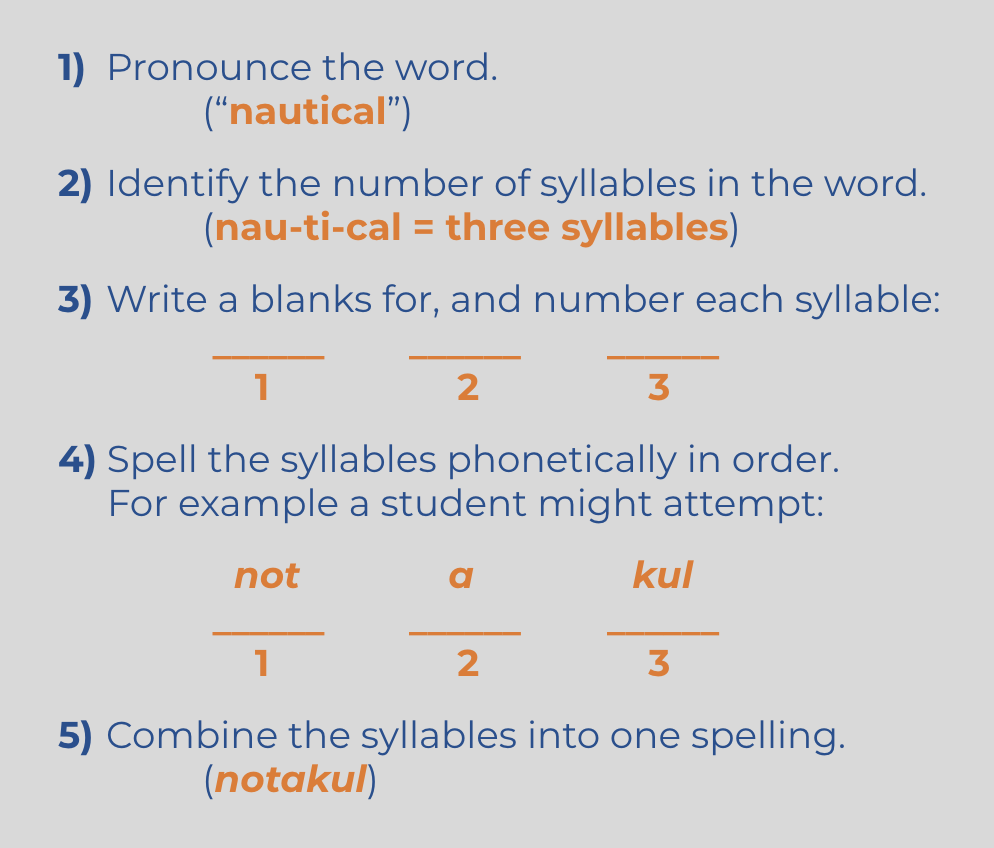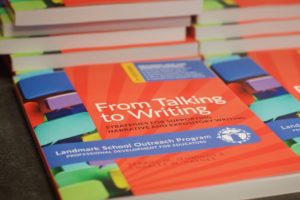November 11, 2018
by Terrill Jennings and Dr. Charles Haynes
In From Talking to Writing (Jennings & Haynes, 2018), we argue that oral language is important for writing; however, differences between these two modes of communication can challenge students with dyslexia and related language learning difficulties. Two major barriers to converting oral language to written text are transcription (sound-symbol coding and handwriting) as well as expository language formulation.
While speakers have to retrieve and express themselves orally, writers need to take an extra step – they must transcribe oral language into words on a page. This “transcription” requires sound-to-letter correspondence rules and handwriting skills. Students with dyslexia may be good at listening and speaking, yet shut down in response to a writing prompt simply because they do not know how to spell words or are blocked by the fine motor requirements of handwriting. For this reason, students with dyslexia benefit from explicit, systematic instruction in spelling rules and handwriting.
Students who have not been taught spelling rules may spell cryptically; for example, they might spell nclat for nautical or casanog for oceanography. These learners often benefit from learning phonetic spelling following the five-step strategy below.

While notakul is still an error, this phonetic spelling is a step in the right direction: it can be read and understood by the student as well as teacher. The teacher should write the target spelling above the student’s phonetic spelling (e.g., nautical above notakul); this ensures the student is at least aware of the target spelling. Phonetic spelling is a useful strategy that frees severely impaired spellers to use more complex vocabulary in their writing.
Deficits in handwriting are another aspect of transcription that often accompanies spelling impairments and are a barrier to written language formulation. Systematic handwriting instruction can 1) enhance spelling and writing fluency as well as 2) aid writing fluency and free up mental energy for higher order thinking.
With oral language, the listener is often present to see and hear the speakers’ gestures and observe changes in prosody and intonation. These nonverbal cues help the listener infer the meanings of sentence fragments and unconsciously repair minor errors in language use. The visual and oral cues inherent in oral discourse tend to be less formal and less explicit than written language. The following conversation about the weather illustrates these less formal features of oral discourse:
Speaker One: Looks like another cloudy day.
Speaker Two: Uh, uh!, It’s sunny now.
Speaker One: Not what the weather guy said.
Speaker Two: No kidding!
In contrast with oral discourse like this, newspapers, business or scientific reports, and textbooks usually employ formal expository structure. These formal texts are explicit and linear, recording a sequence of facts and concepts for the reader’s reference at a time when the writer is not physically present. Because the reader can return and reread the text, vocabulary is more specific and sentences are typically longer, containing more linked or embedded clauses. Also, the larger discourse structure is more formal, having a sequenced content with a beginning and end. The following written weather report illustrates these expository features:
Welcome to Tuesday’s weather report. Today’s weather will have a cloudy start with a slight breeze coming from the northwest, however, there will be a glimpse of sun towards mid-morning, and the day’s temperature will rise to 50 degrees by noon. The advice for children heading to school is to wear a warm jacket. A possible light frost is forecast for this evening with the temperature lowering to a cool 38 degrees. This concludes our forecast for the day.
Extensive reading provides a model for writing, and students who have read widely are better able to engage in formal writing; they have acquired knowledge to support their ideas and have learned a variety of sentence and paragraph structures that are reflected in their writing. In contrast, students with dyslexia and related language learning disabilities struggle to formulate expository language. These struggling writers benefit from systematic teaching that supports writing skills at the vocabulary, sentence, paragraph, and multi-paragraph level.
At the word level, theme-centered vocabulary instruction is key. Humans acquire vocabulary around unifying themes, and a thematic focus on word knowledge enhances students’ background knowledge. The same set of key vocabulary words should be recycled in sentence learning. In the area of sentence development, teachers should introduce sentence patterns gradually, moving from simple to more complex. The sentence is the meaning bearer of the language and sentence patterns reflect logical relationships; therefore, students’ mastery of meaningful sentence structures provides a foundation for understanding and expressing logic at the paragraph and multi paragraph levels. Oral rehearsal of sentence patterns and listening practice, followed by reading and writing exercises allows students to internalize expository sentence patters.
The logic of the paragraph depends on mastery of sentence-level content and logic as well as the ability to link sentences logically to produce smooth flow and cohesion. When students master sentence patterns, this mastery saves mental energy and allows them to focus their cognitive resources on discourse-level language formulation. At the paragraph and multi-paragraph level, students benefit from systematic instruction in strategies for formulating text structures. This instruction begins with sequential narratives and is followed by practice with formulating expository texts, such as required for description, enumeration, and comparison/contrast.
Although the features of oral language and writing may appear to be identical, understanding some of their key differences can help us to support struggling writers. By learning transcription knowledge and skills such as phonetic spelling, spelling rules and handwriting, students are better able to get their ideas on paper. Theme-centered word, sentence and discourse writing skills can help students to internalize strategies to support their expository writing. Readers of this blog will find in-depth, hands-on techniques and strategies in the updated and significantly expanded second edition of our book From Talking to Writing published this year and available through Landmark Outreach.

Terrill Jennings, a founding teacher of Landmark School, has taught students with dyslexia for more than forty years. Recipient of the 2016 Alice H. Garfield Award from the International Dyslexia Association, she has chaired the Language Arts department at Landmark’s Elementary•Middle School and co-founded Landmark’s Expressive Language Program.
Dr. Charles Haynes is a professor and clinical supervisor at the MGH Institute of Health Professions in Boston who has over thirty years of experience educating children and adolescents with dyslexia. A recipient of international honors and awards for his teaching, Dr. Haynes helped pioneer Landmark School’s Expressive Language Program.
Want to learn more strategies to help students improve their written expression? Check out the recently published second edition of their book From Talking to Writing.
Purchase the Book
Check out these additional writing articles, web sites, and Free Landmark Teaching Strategies that can be found on our web site.
View Resources

